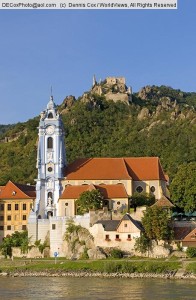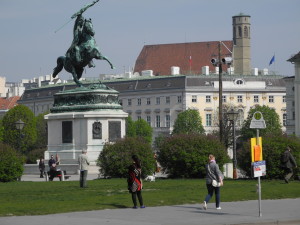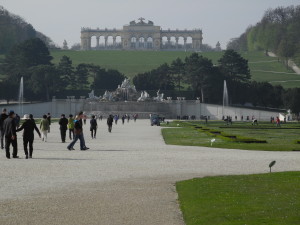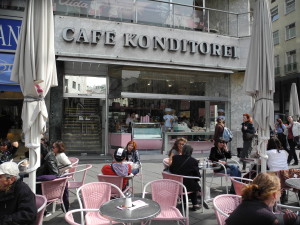
The village of Durnstein lies on the Danube in Austria’s beautiful Wachau Valley. Photo by Dennis Cox/WorldViews
In my last post, Fifteen Things I Didn’t Know About Vienna, Austria, I confessed that there was a lot I didn’t know about Vienna, despite having visited there a number of times in the past.
But those visits had been quite a few years ago, and I had forgotten what a beautiful city Vienna is.
Vienna, in fact, has ranked number one of all the world’s cities for the past three years in the Mercer Quality of Living rankings for expatriates, based on 39 factors such as infrastructure, amenities, health care, etc. I could definitely see living here, though I’d have to brush up on my German, which consists of three words: bier, danke and Auf Wiedersehen. (Well, I guess that’s four.) And, oh yes, wein. And wurst. And kaffee. And herrentoilette. So I’d probably be OK anyway.
My visit to Vienna this time was brief — less than 24 hours — but packed with experiences and sightseeing, thanks to the efficiency of Insight Vacations, the tour company that had invited me as part of an international journalist contingent to sample their trips through Central Europe.
We were treated to a condensed version of their normal tours, which spend multiple nights in Vienna, and it was difficult to leave after getting a brief taste of what Vienna had to offer, including some fine sausages, beer, pastries and coffee for lunch. (The fact that Budapest beckoned later that day helped alleviate that, but that will be for my next post.)
The previous day, after some post-lunch wine tasting in the town of Durnstein in Austria’s beautiful Wachau Valley, where the Danube flows and Richard the Lionhearted was once imprisoned, we had arrived in Vienna late in the afternoon. We checked into the Hilton, a modern hotel overlooking Stadtpark (City Park), where the famous gilded statue of Johann Strauss draws photographers like flies to honey.
But I didn’t have time to enjoy the view since we were whisked away to a private performance of Viennese music and dance at the 1777-vintage Palais Auersperg (Auersperg Palace), where Mozart once composed. This is one of Insight’s “Signature Experiences,” something I would not have known to do on my own, and it proved a delightful surprise. The palace has a grand double staircase and we were seated in a room fit for a Mozart opera, which was once staged here by Mozart himself.
The performance by the Vienna Residence Orchestra, which consisted of instrumental music by both Mozart and Strauss, was augmented by two opera singers (one male, one female) and a bit of dancing. The Mozart portion, featuring music from The Magic Flute and Don Giovanni, was more serious, while the Strauss portion was rousing and fun, highlighted by the Blue Danube Waltz and Radetzky March. The orchestra and opera singers drew a standing ovation at the end.
One of our group, an American living in Italy, volunteered to play the triangle on stage at one point during the more relaxed Strauss portion, and proved he had made the right decision by becoming a writer — though he did insist on being addressed as “maestro” for the rest of the trip. (You can read all about his adventures at The Palladian Traveler.)
It was then time for dinner, and we split into groups of ten each to sample three typical Viennese restaurants. Most at our table ordered Wienerschnitzel, which seemed only appropriate in Wien, as Vienna is known locally. (Viennese are known as Wieners, not to be confused with wursts, which are sausages.) Wein and bier were consumed as well, including after-dinner partying, mostly by the younger journalists among us. Others went out photographing the city at midnight and beyond, while some of us went to sleep — all part of the job.
Bright and early the next morning we piled into our bus, somewhat bleary eyed, to make the journey to Schönbrunn Palace, the summer palace of the Habsburgs, who ruled an empire from Vienna for more than 600 years. As I noted in my earlier post, the gardens at Schönbrunn are as big as the country of Monaco, and despite the palace’s nearly 1,500 rooms and 3,000 servants to tend them, Empress Maria Theresa, who ruled from 1640-80, considered it too small for her needs. She called it a “cottage.”
Maria Theresa had 16 children in just 20 years, and our guide noted that her husband died 15 years previous to her, probably “from exhaustion,” though it seems to me he got the better of the deal.
After exploring the gardens, or at least some of them, we headed off for a whirlwind tour of the old city, which is surrounded by a ring road where walls used to stand (the walls came in handy when the Turks repeatedly and unsuccessfully tried to storm the city in the 17th century).
The old city is replete with enormous Baroque buildings, including the Habsburgs’ Winter Palace, known as the Hofburg, which has 3,000 rooms, more to Maria Theresa’s liking. This was the true center of power in the Austro-Hungarian Empire, which controlled much of Central Europe and beyond (as far away at one time as Spanish colonies in the Americas) until World War I burst its bubble. The Hofburg is larger than the Louvre in Paris and is now home to some 20 museums, which could keep you occupied for weeks.
After the war, Austria went from ruling an empire to a small country of less than seven million people (now about 8.4 million), though it has produced a varied set of native sons and daughters ranging from Sigmund Freud to Adolf Hitler, Arnold Schwarzenegger to the Von Trapp family singers, who inspired “The Sound of Music.”
According to our tour director, Neira, the film “Sound of Music” is barely known in Austria. And here’s another bit of random trivia from Neira: Austria has the highest rate of overweight men in the European Union, while Austrian women are the least overweight in the E.U. Make of that what you will, but I suspect it has something to do with bier. More research is needed.
After grabbing a quick stand-up lunch of wursts and bier with two other journalists, followed by a pastry and coffee at a cafe on a pedestrian street in the shadow of beautiful St. Stephen’s Cathedral — we rushed to fit in these iconic Viennese experiences before the bus was scheduled to leave — we were on our way to Hungary.
In just over 24 hours in Austria, I had enjoyed a wine tasting in a lovely vineyard near the Danube, attended a concert, visited three palaces, dined on Wienerschnitzel and wursts, toured a cathedral, occupied a front-row seat in a busy Viennese cafe, driven around the ring surrounding the old city, picked up various pieces of interesting trivia, and rekindled a love affair with a country I hadn’t visited for 25 years. All a tribute to Insight’s organizational skills and to our tour director, who ran a tight ship, despite the fact that rounding up journalists is akin to herding cats.
So I’m grateful to Insight Vacations for this whirlwind tour — and if you go with them, be assured you’ll spend more time in Austria than we did. But for us, it was on to Budapest — another city no one should miss.















Leave a Reply